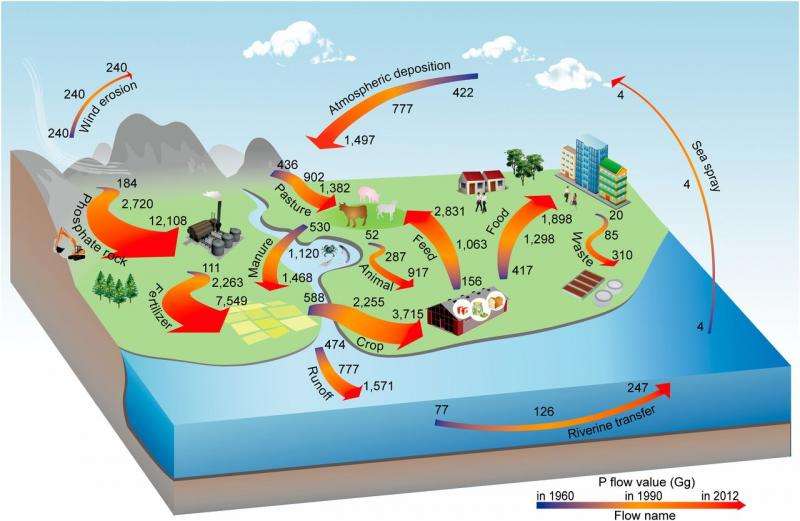Schematic model of P cycles in mainland China during 1960–2012. Systems here may be imbalanced because only aggregated key P flows balanced with import/export data are displayed for the sake of easy comprehension. The thickness of the arrows denotes the historical intensity of key P flows in 1960, 1990, and 2012. Credit: Proceedings of the National Academy of Sciences (2016). DOI: 10.1073/pnas.1519554113
(Phys.org)—Phosphorus is a necessary component of fertilizers needed for agriculture. In 2013 about 225 million tons of phosphate was extracted predominantly for fertilizer use. This rate could diminish the Earth's phosphorus stores and upset phosphorus cycling. China is the world's largest producer of phosphate rock (48% of the world's supply in 2013). It also uses a large amount of phosphorus to sustain its growing population.
Because of China's key role in supplying and consuming phosphorus, it is important to quantify China's phosphorus pathways. Prior studies on China's changing phosphorus cycle were done over a limited time scale and focused on agricultural production rather than the entire phosphorus cycle, which includes both naturally-occurring phosphorus flows as well as other human activities. A group of researchers from Nanjing University have, for the first time, quantified the entire phosphorus cycle across China over the past four centuries using modeling systems and historical datasets. Their work appears in the Proceedings of the National Academy of Sciences.
Xin Liu, Hu Sheng, Songyan Jiang, Zengwei Yuan, Chaosheng Zhang, and James J. Elser used models to analyze the dynamic changes of the Chinese phosphorus cycle from 1600 to 2012 using several data parameters, including naturally-occurring sources such as atmospheric phosphorus and inland and marine waters; anthropogenic sources such as mining, chemical production, agriculture, animal husbandry, and human consumption; and phosphorus form trade.
They also investigated the eutrophication potential caused by human-induced phosphorus losses in mainland China by region. Their models analyzed the dynamic changes of the Chinese phosphorus cycle from 1600 to 2012 using several data parameters, including naturally-occurring sources such as atmospheric phosphorus and inland and marine waters; anthropogenic sources such as mining, chemical production, agriculture, animal husbandry, and human consumption; and phosphorus from trade.
According to the research article, their overall goal is to understand "phosphorus's long-term temporal dynamics and the regional disparity of the eutrophication impact." They hope that this extensive study can be used to develop strategies for phosphorus management that establish a more sustainable phosphorus cycle.
Eutrophication is the environmental response to an overabundance of a particular nutrient, in this case phosphorous. One way that eutrophication occurs is through phosphorus run-off in freshwater systems. It spurns the overgrowth of algae, plankton, and other surface-level water plants. This overgrowth has consequences for all parts of the phosphorus cycle.
Liu, et al.'s studies addressed the effects of phosphorus production and consumption in fourteen different compartments in the phosphorus cycle. Using statistical methods and data acquired from various reputable sources that catalogued phosphorus production, detection, and use from 1600 to 2012, they were able to discern broad temporal trends in the phosphorus cycle in China and identify which regions faced the most dramatic eutrophication potential in 2012.
The results of these studies show that there are higher anthropogenic phosphorus emissions where there is a greater population density, namely in the eastern and central regions of mainland China, with the highest emissions in Shanghai. Historically, this trend was most notable as urbanization increased and phosphorus emissions from human waste increased in these areas. Additionally, studies of eutrophication potential show that greatest impact of phosphorus emissions (in 2012) were around the Yangtze River Basin.
This data is both helpful for localizing where phosphorus emissions cluster and identifying which regions are at a high risk of ecosystem damage.
More information: Xin Liu et al. Intensification of phosphorus cycling in China since the 1600s, Proceedings of the National Academy of Sciences (2016). DOI: 10.1073/pnas.1519554113
Abstract
Phosphorus (P) is an essential nutrient for living systems with emerging sustainability challenges related to supply uncertainty and aquatic eutrophication. However, its long-term temporal dynamics and subsequent effects on freshwater ecosystems are still unclear. Here, we quantify the P pathways across China over the past four centuries with a life cycle process-balanced model and evaluate the concomitant potential for eutrophication with a spatial resolution of 5 arc-minutes in 2012. We find that P cycling in China has been artificially intensified during this period to sustain the increasing population and its demand for animal protein-based diets, with continuous accumulations in inland waters and lands. In the past decade, China's international trade of P involves net exports of P chemicals and net imports of downstream crops, specifically soybeans from the United States, Brazil, and Argentina. The contribution of crop products to per capita food P demand, namely, the P directly consumed by humans, declined from over 98% before the 1950s to 76% in 2012, even though there was little change in per capita food P demand. Anthropogenic P losses to freshwater and their eutrophication potential clustered in wealthy coastal regions with dense populations. We estimate that Chinese P reserve depletion could be postponed for over 20 y by more efficient life cycle P management. Our results highlight the importance of closing the P cycle to achieve the cobenefits of P resource conservation and eutrophication mitigation in the world's most rapidly developing economy.
Journal information: Proceedings of the National Academy of Sciences
© 2016 Phys.org






















